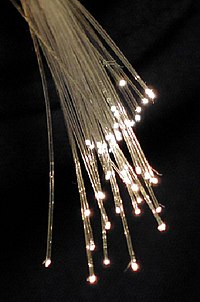
Photo from wikipedia
Stimulated Brillouin scattering (SBS) microscopy is emerging as a promising approach for mechanical imaging in biological settings. It is based on a spectroscopic backscattering SBS setup, but with scanning of… Click to show full abstract
Stimulated Brillouin scattering (SBS) microscopy is emerging as a promising approach for mechanical imaging in biological settings. It is based on a spectroscopic backscattering SBS setup, but with scanning of the sample and using higher apertures of the excitation and collection optics for adequate spatial sampling. Here, we provide direct experimental measurements and theoretical predictions of the aperture-induced spectral effects of SBS microscopy in water—a key constituent of biological systems. It is shown that with increasing numerical aperture (NA), the Brillouin frequency shift and peak gain decrease, while the Brillouin linewidth broadens asymmetrically with the commencing of an extended tail in the low frequency region for NA > ∼0.5. Further, significant distortions of the Brillouin spectral line shape are predicted for NAs close to 1, affecting the ability to retrieve spectral parameters of the Brillouin medium precisely and accurately.
Journal Title: Applied Physics Letters
Year Published: 2023
Link to full text (if available)
Share on Social Media: Sign Up to like & get
recommendations!